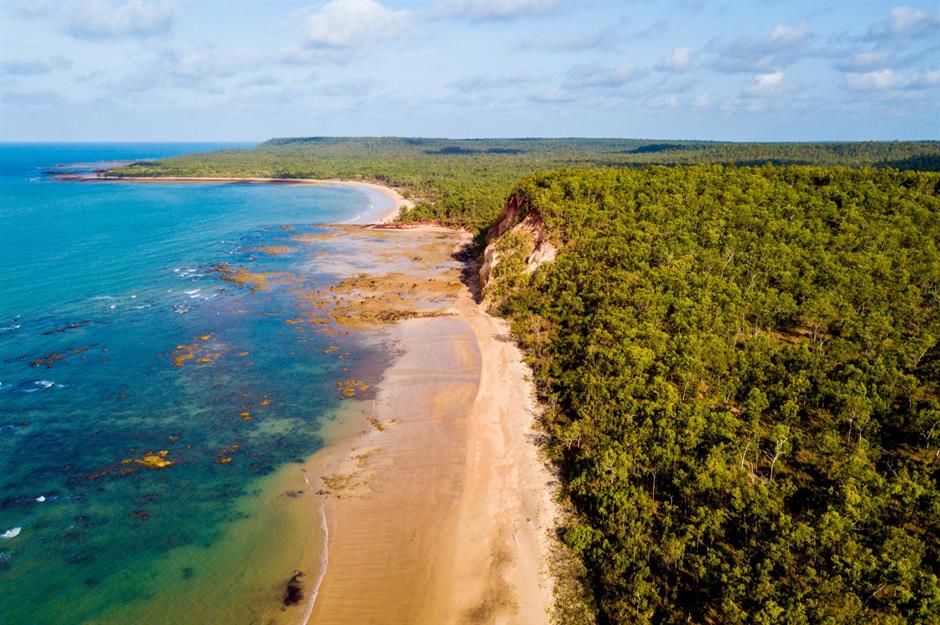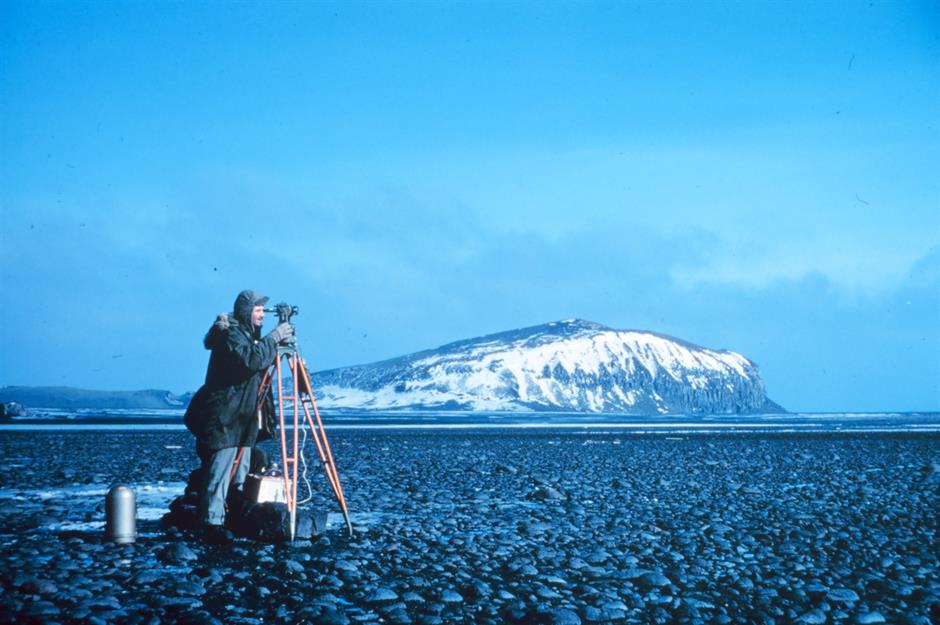Places you can’t visit in Australia
No-go zones
Australia is packed with must-visit destinations, but it has some fascinating no-go spots too. Whether it's due to conservation reasons, because they're sacred Indigenous-owned areas, or because they’re simply too dangerous for tourists, these places are off limits.
Click through the gallery to discover the places you can't visit in the wonderful land of Oz...
Heard Island
Volcanoes and glaciers are not what you’d expect to see in Australia. And sadly you won’t get a chance to visit wild and remote Heard Island, one of Australia’s most spectacular, hidden spaces. The little-known landmass, located in the southern Indian Ocean about halfway between Australia and South Africa, is home to incredible wildlife including three species of seal, four species of penguin and two endemic bird species – the Heard Island sheathbill and the Heard Island cormorant.
Heard Island
Access to the inhospitable subantarctic island, which has the nation’s highest active volcano, known as Big Ben, is strictly restricted to keep it free of introduced animal pests. Along with the McDonald Islands it was added to UNESCO's World Heritage List in 1997. Visits are strictly regulated, so you’re highly unlikely to be able to go unless you’re part of a scientific expedition. Should you be granted access, you face a two-week voyage from Australia across some of the planet’s roughest seas.
Pine Gap, Northern Territory
All sorts of rumours swirl about this remote and covert Australian-American military base set in the central Australian desert just southwest of Alice Springs. Commonly known as Pine Gap, it’s officially called the Joint Defence Facility Pine Gap and is totally off limits to anyone but officials. Exactly what goes on in there is a closely guarded secret, but it inspired a Netflix series called Pine Gap.
Pine Gap, Northern Territory
Wittenoom, Western Australia
Wittenoom is notoriously the most contaminated site in the Southern Hemisphere and the government compulsorily acquired its last properties in 2019 to close off the town – though, incredibly, tourists have been known to still visit the area, despite clear signs warning of the deadly risks. More than 2,000 workers and residents of Wittenoom have died from asbestos-related diseases.
Wittenoom, Western Australia
Based in Western Australia's Pilbara region, the former mining town sits at the mouth of the Wittenoom Gorge. As Australia's only asbestos mine, it was at its peak from 1950 through to the early 1960s. It was officially removed from Western Australian maps in 2007, but remains a blight on the country's mining past.
Love this? Follow us on Facebook for more intriguing tales from around the world
Point Nepean National Park, Victoria
Point Nepean National Park, Victoria
Carnac Island, Western Australia
Carnac Island, Western Australia
It’s possible to visit the island by boat to see the sea lions – although there is a small exclusion zone to allow the sea lions somewhere to escape ogling tourists – but the interior is totally off limits due to the snakes. It’s rumoured that a snake showman called Rocky Vane released the tiger snakes on Carnac Island in around 1903, after his wife and then his partner were both fatally bitten by his snakes.
Cartier Island Marine Park
This small sand cay, which lies 373 miles (600km) north of Broome and is closer to Indonesia than Australia, is within a 66-square-mile (172sq km) marine reserve where around 16% of Australia's fish species can be found. Cartier Island and its surrounding reefs have been prime fishing grounds for Indonesian fishermen for centuries looking to collect birds, bird's eggs, clams, sea cucumber, shells, turtles and turtle eggs. It is now an official sanctuary zone and entering or anchoring is strictly forbidden.
Cartier Island Marine Park
The zone not only protects the marine park's biodiversity – it is an important habitat for sea snakes, turtles, whale sharks, corals, sea fans and sponges – but also safeguards vessels against unexploded ordnance. Cartier Island and the water up to a radius of six miles (10km) was used as a Defence Practice Area up to 2011 so there is a real risk that unexploded weapons remain in the area.
Albatross Island, Tasmania
As its name suggests, this lonely little isle in the Bass Strait, strewn just off the coast of northwest Tasmania, is home to 10,000 rare shy albatrosses. It’s one of only three islands where Australia's only endemic species of the spectacular seabird lives. Unless you’re a conservationist, you have no chance of seeing this magnificent colony of birds. They're protected due to their vulnerability to rising air temperatures (which are very harmful to chicks), warming oceans and torrential rainfall.
Dorre Island, Western Australia
One of three islands that make up the Bernier and Dorre Island Nature Reserve in the Shark Bay World Heritage area in Western Australia, Dorre Island is an uninhabited wilderness that is home to some of the world's rarest wildlife. If you were to visit you might spy the Shark Bay mouse, western barred bandicoot, banded hare-wallaby or rufous hare-wallaby. Dorre Island is under a wildlife protection quarantine as it is one of only two islands free of a fatal wart virus that affects the threatened western barred bandicoots, so landing is currently prohibited to prevent the spread of the virus.
Arnhem Land, Northern Territory
Arnhem Land, Northern Territory
Over twice the size of Switzerland, Arnhem Land has a population of around 16,000, who mostly live in small outstations, and is Aboriginal-owned. The traditional home of the Indigenous Yolngu people, it is rich in culture and notably home to some of the country’s finest rock art galleries. It’s also where the didgeridoo was invented. There are tours into the region, where operators negotiate permits, but there are many areas in this immense region that are completely inaccessible – especially in the wet season (November to April) when the roads and tracks become impassable.
Elliot Price Conservation Park, South Australia
A vast and lonely conservation area in the arid depths of central Australia, Elliot Price Conservation Park was established to help conserve the extraordinary wilderness of a southern section of the immense Kati Thanda (Lake Eyre), the country’s largest salt lake. It covers the Hunt Peninsula and Brooks Island and, with all access prohibited, the area is totally untouched.
The Blue Hole, Queensland
Deep in the ancient tropical rainforest of Daintree National Park in far north Queensland, the Blue Hole is a sacred women's place for the Jalunjiwarra clan of the Eastern Kuku Yalanji people. Men are forbidden to visit and women must be invited to the area, a traditional healing pool and birthing place, by the traditional owners. Signs urge visitors to respect the sacred site with the Jalunjiwarra believing unwelcome visitors in the waters will experience health problems.
Swan Island, Victoria
The sand barrier island near Queenscliff has a long history of military use, with a fort first established here in the 1870s to protect the entrance to Port Phillip Bay from potential Russian invasion. It was used as a depot for naval mines in the First World War and has been used as a training area since the Second World War. No one knows exactly what goes on in the Swan Island Military Base but rumour has it that Australia's Special Forces currently carry out counter terrorism training here. Whatever is happening, there is no chance of you visiting this top-secret facility, but you can stare across at it and let your imagination run riot.
Woomera Prohibited Area, South Australia
The Stuart Highway cuts through the prohibited area of the RAAF Woomera Range Complex, but you're not allowed to venture off the highway without a permit. The large weapons testing range, which was established in 1947 by Britain and Australia and covers a whopping 47,177 square miles (122,188sq km), has been used for nuclear testing in the past.
Woomera Prohibited Area, South Australia
Uluru, Northern Territory
Uluru, Northern Territory
Just before the ban came into effect, hundreds of tourists scrambled to scale the sacred monolith for a final time. The climb to the summit of Uluru – which stands 1,142 feet (348m) high – is steep and slippery and has resulted in at least 37 fatalities. Now visitors to the Red Centre will have to content themselves with a walk around the mighty rock’s remarkable circumference.
Heart Reef, Queensland
This cute, heart-shaped formation near the Whitsundays in the Great Barrier Reef Marine Park has become one of Australia’s most familiar landmarks, appearing in numerous tourism campaigns – but you won’t get to see it up close. Heart Reef has protected status so it’s forbidden to sail or snorkel here. You can however circle above to admire it on a scenic flight or helicopter tour.
Now check out these former no-go zones that you can actually visit

